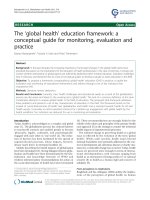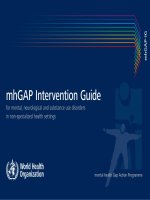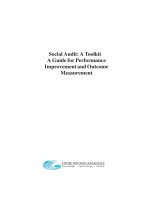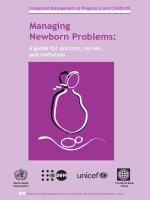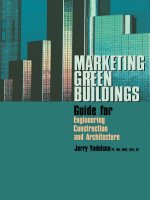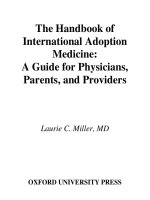marketing green buildings - guide for engineering, construction and architecture
Bạn đang xem bản rút gọn của tài liệu. Xem và tải ngay bản đầy đủ của tài liệu tại đây (32.84 MB, 262 trang )
i
Marketing Green Buildings:
Guide for Engineering,
Construction and Architecture
This page intentionally left blank
iii
Marketing Green Buildings:
Guide for Engineering,
Construction and
Architecture
Jerry Yudelson, PE, MS, MBA, LEED® AP
iv
Library of Congress Cataloging-in-Publication Data
Yudelson, Jerry.
Marketing green buildings: guide for engineering, construc-
tion, and architecture/Jerry Yudelson.
p. cm.
Includes bibliographical references and index.
ISBN 0-88173-528-0 (print) ISBN 0-88173-529-9 (electronic)
1. Green marketing. 2. Sustainable buildings Marketing.
3. Architectural services marketing. 4. Architects and builders
Certifi cation. 5. Construction industry. I. Title.
HF5413.Y83 2006
690.068’8 dc22
2005058224
Marketing green buildings: guide for engineering, construction, and architec-
ture/by Jerry Yudelson
©2006 by The Fairmont Press, Inc. All rights reserved. No part of this pub-
lication may be reproduced or transmitted in any form or by any means,
electronic or mechanical, including photocopy, recording, or any informa-
tion storage and retrieval system, without permission in writing from the
publisher.
Published by The Fairmont Press, Inc.
700 Indian Trail
Lilburn, GA 30047
tel: 770-925-9388; fax: 770-381-9865
Distributed by Taylor & Francis Ltd.
6000 Broken Sound Parkway NW, Suite 300
Boca Raton, FL 33487, USA
E-mail:
Distributed by Taylor & Francis Ltd.
23-25 Blades Court
Deodar Road
London SW15 2NU, UK
E-mail:
Printed in the United States of America
10 9 8 7 6 5 4 3 2 1
0-88173-528-0 (The Fairmont Press, Inc.)
0-8493-9381-7 (Taylor & Francis Ltd.)
While every effort is made to provide dependable information, the pub-
lisher, authors, and editors cannot be held responsible for any errors or
omissions.
v
Table of Contents
Acknowledgements vii
How to Read This Book ix
1. Introduction 1
2. Today’s Green Building Market 9
3. Industry Growth to Date 23
4. Forecasting Demand for Green Buildings 37
5. The Business Case for Green Buildings 51
6. Experiences of Green Marketing 69
7. Vertical Markets for Green Building 83
8. Demand for Green Building Measures 99
9. Understanding Marketing Strategies 119
10. Understanding Segmentation, Targeting,
Positioning and Differentiation 133
11. Selling Green Buildings 153
12. Marketing Green Developments 169
13. Looking to the Future: Sustainable Engineering Design 187
14. Marketing Services for LEED-EB Projects 197
15. Marketing Services for LEED-CI Projects 205
16. Marketing Services for Future LEED Products 211
17. The Role of the Professional Engineer in Energy Star
®
221
18. Forecasts of Demand for LEED Projects 229
19. The People Problem in Marketing Professional Services 233
Appendix 237
Index 249
This page intentionally left blank
vii
Acknowledgements
My wife, Jessica Stuart Yudelson, (and my Scottie, Madhu) put up
with the “magnifi cent obsession” to write this book, during evenings and
weekends of 2004 and 2005 in Portland. This book is dedicated to them.
Bob Fox of Cook+Fox Architects in New York generously updated me in
September 2004 about the One Bryant Park development. Susan Kaplan
of Battery Park City Authority, New York City, took the time to give me a
tour of The Solaire, the fi rst LEED
®
Gold apartment building.
My former colleagues at Green Building Services, Portland, provided
some helpful information from their work on LEED-certifi ed projects,
as did my friends at Swinerton Builders, Portland. Thanks to Hamilton
Hazelhurst, Vulcan Development, for his time in discussing how a major
developer tackles green development, and to Alison Jeffries, marketing
director, for her information on specifi c projects. I also benefi ted from
talking with Jim Goldman and Rod Wille of Turner Construction about
the implementation of their company’s green building program.
We used some materials, with permission, from the April 2004
issue of The Marketer, the monthly magazine of the Society for Marketing
Professional Services (SMPS). Karen Childress of WCI Communities
in Florida guided me through the decision-making process of a major
residential developer. The Civano community in Tucson shared some of
their photographs, and my friends at Gerding/Edlen Development in
Portland shared a copy of a 2004 advertisement for their green development
projects.
My many friends and colleagues in the green building design,
development and construction business in Portland, Seattle, San Francisco,
Vancouver and other places, have always been there with helpful advice
and solid information. Thanks also to the reviewers who lent their
expertise, and to Lynn Parker for professional graphic design assistance.
This page intentionally left blank
ix
How to Read This Book
People have different interests in the business of green buildings and
sustainable design. This short guide will help you fi nd the information
you need. This book is meant to be read from front to back, but can be read
one chapter at a time also. The tables, charts and graphs can also be read
separately to gather useful (and often hard-to-fi nd) information.
MARKETING ARCHITECTURAL SERVICES
Read Chapters 6, 7, 9 and 10 particularly.
MARKETING ENGINEERING SERVICES
Read chapters 6, 7, 9, 10, 13, 14 and 17.
MARKETING CONSTRUCTION SERVICES
Read chapters 6, 7, 9, 10 and 13.
MARKETING GREEN DEVELOPMENTS
Read Chapters 10, 11, 13 and 15.
UNDERSTANDING DIFFERENTIATION AS A GREEN BUILDING AND
FIRM MARKETING STRATEGY
Read chapters 6, 8 (part three), 9, 10, 11 and 12.
MARKETING SOLAR POWER SYSTEMS
Read chapters 8 and 10.
MARKETING ENERGY EFFICIENCY TO THE COMMERCIAL
BUILDING MARKET
Read chapters 5 and 8 especially, as well as chapters 2, 3, 14 and 17.
UNDERSTANDING THE MARKET FOR GREEN BUILDINGS
Read chapters 3 and 4 especially, as well as chapters 6 and 7.
UNDERSTANDING THE VIEWPOINT OF THE CLIENT FOR GREEN
BUILDINGS
Read chapters 5, 6, 7 11 and 12.
x
THE FUTURE OF GREEN BUILDINGS
Read the forecasts in chapter 4 as well as chapter 18.
FINDING RESOURCES FOR FURTHER STUDY
Read the footnotes and chapter references, as well as the appendix.
SETTING BUSINESS STRATEGY FOR YOUR FIRM
Read chapters 6, 9 and 10, as well as the forecasts in chapters 4 and 19.
UNDERSTANDING THE GROWTH AND MARKET ACCEPTANCE OF
THE LEED GREEN BUILDING RATING SYSTEM
Read chapters 2, 3, 4 and 5, as well as chapters 8, 9 and 18.
Introduction 1
Chapter 1
Introduction
Let’s review what has happened in the green building marketplace,
since the introduction of the LEED system in April of 2000:
• Membership in the U.S. Green Building Council, the primary industry
association has increased from about 600 corporate members at
the end of 2000 to more than 5,500 members at the end of August,
2005, representing tens of thousands of design and construction
professionals, as well as public agencies, environmental groups,
building owners, property managers and developers.
• The LEED green building rating system has certifi ed more than 350
completed projects, as of December 2005.
• More than 2,400 projects were registered at the end of December
2005 for certifi cation under LEED, representing 50 states and 13
foreign countries, including Canada, Spain, India and China.
Thousands of other projects are using the LEED evaluation system
without formally registering with LEED. (Nearly 30% of the LEED
registered projects are in California, Oregon and Washington,
making the West Coast the “hot spot” of national green building
activity at this time.)
• Nearly 29,000 professionals have taken the all-day LEED Technical
Review eorkshop covering the basics of the LEED system.
• More than 21,000 building industry professionals have passed a
national exam and become “ LEED Accredited Professionals.”
• The U.S. Green Building Council’s third annual Greenbuild conference
and trade show in Portland, Oregon, in November 2004 conference
in Portland drew nearly 8,000 people, and the 2005 show in Atlanta,
Georgia, drew nearly 10,000 attendees.
1
2 Marketing Green Buildings
By anyone’s reckoning, LEED is the fastest growing voluntary
program to affect the design and construction industry in many years.
LEED registrations are expected to grow more than 30% per year through
2007 and more than 25% per year through 2010. Understanding LEED and
how to use it effectively in marketing a design or construction fi rm has
become more important in the past few years. As clients’ knowledge of,
and comfort with, the LEED system grows over time, they will increasingly
demand that their designers and builders understand how to use the
system and how to achieve LEED results with little or no up-front design
or construction cost. In effect, LEED has “raised the bar” for all building
industry professionals. Not being up to speed on LEED, not having
successful LEED projects in one’s portfolio, will put fi rms increasingly at
a signifi cant disadvantage in our hyper-competitive marketplace.
This book raises and attempts to answer several key questions: How
is green building marketing similar to all other types of professional service
marketing, and how is it remarkably different? What available tools and
techniques from conventional marketing can we use to greater effect in
marketing green buildings? What is in fact the size of the market for green
buildings? How can we estimate the future growth of this market? Who
are the winners thus far in green marketing? How should a fi rm position
itself to succeed in this growing marketplace?
To quote Tom Watson, the modern marketing genius behind IBM,
“Nothing happens until a sale is made.” Green building architects and
engineers need a fi rm grounding in marketing theory and contemporary
marketing strategy and tactics to be effective in this rapidly changing
marketplace. Conventional professional fi rm marketers and account
executives need to understand what the green building client, customer
or consumer really wants, to be more effective in presenting green design
features, sustainable strategies and new products to this new type of
buyer.
PURPOSE OF THIS BOOK
This book presents the special features of marketing green buildings.
It is designed for “professionals,” people such as yourself whose livelihood
depends on successfully marketing design and construction services,
building projects, developments with green features and systems to serve
these projects. There are thousands of us out there, trying to transform
Introduction 3
the building industry into a more energy-effi cient and environmentally
responsible activity, and we’re doing it one presentation, one meeting, one
design, one project, one product at a time.
ORGANIZATION OF THE BOOK
This book is organized into 19 chapters and appendix.
• Chapters Two and Three start out by looking at the green building
market as it exists today, including the size of the market and
especially the projects and products that have been successful from
the late 1990s through 2005.
• Chapter Four presents factors infl uencing green building demand as
well as short-term forecasts through 2007.
• Chapter Five looks presents the business case for green buildings,
including both economic and “non-economic” factors.
• Chapter Six reviews survey data from specifi c experiences of green-
design marketing that have successfully positioned fi rms for growth
in this area, as well as case studies.
• Chapter Seven examines a few specialized “vertical” building
markets, to see where the green building business is today and where
it is trending.
• Chapter Eight looks at the current state and future success of
several green-building technologies, and it offers a special focus on
marketing solar power systems.
• Chapter Nine looks at the marketing approaches of selected
professional service fi rms and also addresses the impact of a fi rm’s
differentiation in this fi eld on attracting good people.
• Chapter Ten reviews classical marketing strategies for emerging
markets such as green building and looks at the theories of “diffusion
of innovations” that have characterized many similar innovative
marketing efforts around the world.
4 Marketing Green Buildings
• Chapter Eleven deals with the practical issues of selling green
buildings and green-building services.
• Chapter Twelve addresses specifi c issues with marketing sustainable
real estate developments, including single-family residential, condos
and offi ce buildings.
• Chapter Thirteen presents a discussion of the evolution of engineering
design from “post modern” to “sustainable.”
• Chapter Fourteen discusses the marketing and professional services
opportunities in the “LEED for Existing Buildings” (LEED-EB) rating
system.
• Chapter Fifteen discusses the marketing and professional services
opportunities in the “LEED for Commercial Interiors” (LEED-CI)
rating system.
• Chapter Sixteen looks to the future, with new editions of the LEED
green building rating system, new technologies and new points of
focus for this emerging industry.
• Chapter Seventeen discusses the professional engineer’s role in
applying the Energy Star
®
rating system to buildings.
• Chapter Eighteen projects the growth of the green building industry
for the rest of this decade, using proven techniques from the fi eld of
technology forecasting.
• Chapter Nineteen discusses the people problem in growing and
operating professional services fi rms in a time of high mobility
among professionals in the building industry.
• The Appendix briefl y lists some resources that you may fi nd valuable
on a continuing basis, including magazines, books, web sites and
list-serves.
Introduction 5
VALUING GREEN BUILDINGS
Green Building Rating Systems
Green buildings today have a variety of rating and certifi cation
systems available, but in the United States, the de facto national rating
system is the U.S. Green Building Council’s “Leadership in Energy and
Environmental Design,” or LEED. In certain “vertical market” segments
such as secondary schools, modifi ed versions of LEED are being used, for
example in California and Washington state, with the standards posted
for California by the Collaborative for High Performance Schools (CHPS,
2004), standards which have also been adopted for schools by the State of
Washington. Similar standards are evolving in the health care industry,
as exemplifi ed by the “ Green Guidelines for HealthCare” (see Chapter
7). All of these ratings systems are “point-based” and focus primarily on
the building itself and the environmental impacts of its construction and
operations. In 2005, a new competitor to LEED in the commercial buildings
market was launched by the Green Building Initiative (www.thegbi.org),
called “ Green Globes,” a self-certifying, web-based checklist system, but
it hasn’t achieved much marketplace interest in its fi rst year of operation
and can’t be considered at this time as a serious competitor to LEED.
A survey of 167 public building owners in mid-2005 by a construction
industry consulting fi rm found that 51% were familiar with LEED and,
of those, 56% planned to implement LEED for some future project.
1
And
60% of the total survey group is incorporating energy-effi cient elements in
their designs. In the education sector, 73% have implemented some form
of energy-effi ciency designs or improvements in the past 12 months, with
40% of those projects using the LEED standards.
Benefi ts of Ratings Systems
Green building rating systems provide some value in the marketplace
today, primarily to institutional building owners and developers, such as
federal, state and local government; schools and universities; nonprofi t
organizations; hospitals, libraries, etc. These represent nearly 65%, for
example, of the fi rst 2,100 buildings registered under the LEED 2.0 system
during its fi rst fi ve-plus years of existence, through September 2005
2
.
Many private, for-profi t building owners have used LEED to evaluate
their buildings and to implement policies for sustainability and corporate
social responsibility, e.g., American Honda Motor Company’s LEED Gold
building in Gresham, Oregon, and the Toyota North American campus
6 Marketing Green Buildings
in Torrance, California. A small handful of private businesses have built
similar buildings for the benefi t of their employees and/or to secure life-
cycle cost savings in operations.
The Value of Green Buildings
The value of buildings depends on the nature of ownership. For
example, a major government agency may construct buildings with a 50-
year (or more) life, whereas a property developer may simply construct
buildings for immediate leasing and short-term sales potential. Each of
these building owners is pursuing different measures of value, and the
task for green building marketers is to recognize this state of affairs and
to tailor their approaches to different owners accordingly. (Chapter 5
discusses the business case for green buildings in more detail; the ability
to articulate this case is important for architects and engineers who want
to convince their clients to “go green” and to reap the business benefi ts of
their commitment to sustainable design.)
Since marketplace values can shift rapidly, depending on the state of
the economy, vacancy rates for properties, interest rates, etc., it is diffi cult
to ascribe exact values for various green building measures. For example,
in today’s low interest rate climate in the U.S., where interest rates are
at historically low levels, it is easier to justify longer-term investments
in energy and water savings, both for government agencies and private
building owners; in other words, the acceptable “payback” can be as long
as seven to ten years, or more.
Buildings also accrue value by having lower operating costs. In a low
interest rate climate, the multiplier of annual savings to get incremental
increases in building value may be as high as 14 (cap rate of 7%), whereas
in higher interest rate environments, it can shrink to 10 (cap rate of 10%).
So, the same projected annual savings in energy and water costs, or benefi ts
of productivity increases, might be worth 40% more in a low-interest-rate
economy.
Marketing benefi ts might also accrue to LEED-rated green buildings,
if they become the standard measure of value for commercial and
institutional construction. Such buildings might be easier to lease or rent
fully, or they might command higher rents or lease rates. At this time,
there is little marketplace evidence that this is the case (see Chapters
11 and 12). If it were easier to lease green buildings, then speculative
developers might be very interested, because a fully leased building prior
to construction is a very valuable commodity. The LEED for Core and
Introduction 7
Shell (LEED-CS) standard, currently in a “beta test” or “pilot” version,
aims to assist developers with a pre-construction certifi cation to help
facilitate early leasing activity; it expects to launch a full-fl edged version
in the spring of 2006.
SUMMARY
Throughout this document, I rely on solid data, current through
September of 2005. Most of this information is publicly available from the
U.S. Green Building Council, from papers at green building conferences,
from trade magazines or is based on my own projections and extensions of
these data. I have also conducted several proprietary surveys and a large
number of personal interviews to round out the picture of green building
given in this book.
I am relying on AEE members, readers and users of this information,
and fellow green building professionals to dialog with me and each other
about the ways we can bring about a successful transformation of the
building industry, to one that produces what most people say they want
from it: energy- and resource-effi cient, environmentally sound, healthy,
comfortable and productive places to live, work, learn, experiment and
recreate.
Thanks for your interest in this book, and happy reading! I welcome
any other feedback, directed to me at my personal e-mail address: jerry.
, or via my personal web site, www.yudelson.net.
Jerry Yudelson, PE, MS, MBA, LEED AP
Portland, Oregon
October, 2005
This page intentionally left blank
Today’s Green Building Market 9
Chapter 2
Today’s Green Building Market
Who are the winners in today’s green-building market? Which fi rms
have developed clear game plans and achieved obvious successes in
marketing green building services and green building projects? Among
the large architectural fi rms, giant HOK (ranked 28th of the largest design
fi rms in the United States, based on 2004 billings, according to Engineering
News Record-ENR)
3
stands out for its early commitment of a group to green
buildings, its sharing of resources with others similarly committed in the
late 1990s and its authorship of one of the leading texts on green buildings.
(The HOK Guidebook to Sustainable Design, by Sandra F. Mendler and
William Odell, New York: Wiley, 2000.) Perkins+Will Architects, number
64 on the ENR list and one of the top large international design fi rms (as
part of DAR Group), is notable for having more than 400 LEED Accredited
Professionals, as is Gensler, number 31 on the ENR list.
Among smaller architectural fi rms of less than 200 employees, a
number of regional fi rms stand out, including BNIM Architects in Kansas
City, Missouri (see case study at end of this chapter);
Mithun
architects in
Seattle, Washington (see case study in Chapter 9); LPA Architects in Irvine,
CA; EHDD Architects in San Francisco; SMWM Architects, San Francisco;
and Overland Partners in San Antonio, Texas. Each of these fi rms is led by
a principal committed to sustainable design, participated in some of the
earliest green-building efforts of the late 1990s, and has stayed abreast of the
green building industry by making an aggressive commitment to innovation
in this area. Not all fi rms and all principals of these fi rms share this passion,
but those who do have also been able to attract smart and dedicated project
architects and designers to their fi rms to implement their visions.
Also worthy of mention is Fox + Fowle Architects of New York City
(now FX Fowle), where principals Robert Fox and Bruce Fowle created the
landmark green high-rise, Four Times Square, the New York Times building;
the 2005 high-rise residential project, The Helena, and other major green
projects in and around New York. A few years ago, Robert Fox formed a
new fi rm, Cook+Fox (www.cookplusfox.com) to construct what would be
the largest LEED Platinum project ever, the 2.1 million sq. ft. One Bryant
9
10 Marketing Green Buildings
Park project in New York City, which broke ground in 2004 and expects
completion and occupancy in 2008 (Chapter 12 case study).
In the engineering fi eld, some large national and international
fi rms, including Flack + Kurtz in New York (plus San Francisco, Seattle,
London, Paris and Washington, with 350 employees, number 226 in
the ENR list), ARUP in London/New York/Los Angeles (73 offi ces,
7000 employees, number 77), and to some degree Syska & Hennessy
(New York and Los Angeles, plus 12 other domestic offi ces and 600
employees, number 104 in the ENR list) have been able to carve out a
niche as the preferred engineers for major projects by major fi rms. Their
size, relatively few offi ces and cost structure have also allowed a number
of regional fi rms to fl ourish in serving the needs of sustainable design-
oriented architects. In Canada, Keen Engineering (acquired in October
2004 by publicly traded Stantec, TSX:STN; NYSE:SXC), has carved out
an enviable niche as the green engineering fi rm of choice; in the past few
years, Keen has extended its reach to a growing number of projects in the
United States, more than doubling in size since 2000, now with 12 offi ces
in the U.S. and Canada. At the beginning of 2005, Keen Engineering (now
merged with Stantec) had shown a greater commitment to the LEED
process than any architectural or engineering fi rm, with about 163 LEED
Accredited Professionals in a staff of about 273
4
. Table 2-1 shows the top
10 construction industry fi rms with LEED Accredited Professionals, as
of July 2005.
There are some specialized consulting fi rms active in this industry,
but they are all generally smaller than 50 people and have “co-evolved”
with the rise of the green building movement. None of the really large
consulting engineering or pure consulting fi rms appears yet to have taken
much of an interest in the green-design business. Some of the noteworthy
consulting fi rms are CTG Energetics in Irvine, California; Paladino &
Associates in Seattle; Green Building Services, Portland– of which the
author was a co-founder; “7 Group” in Pennsylvania—a federation of
independent consultants; and Elements in Kansas City, Missouri, a spin-
off of BNIM Architects that is gradually taking on its own identity.
What do all of these fi rms have in common? They are technical
leaders in sustainable design. They have been early entrants into the fi eld.
They have the size, scope and—in some cases—prime location to be at the
nexus of sustainable design developments. They have worked on some
of the landmark projects in this emerging industry. They are attractive
companies to work for and as a result have attracted good young talent—a
Today’s Green Building Market 11
Table 2-1. LEED Accredited Professionals
5
12 Marketing Green Buildings
must in the intense and highly competitive architecture, engineering and
construction industry. They excel at personal and fi rm public relations, and
they have participated in a variety of industry forums and associations.
We will explore many of these attributes in the course of discussing how
fi rms should market to the green building industry.
Consider these facts: there are more than 21,000 LEED Accredited
Professionals as of September 2005 and nearly 29,000 have participated
in LEED training workshops. But only 2,400 LEED-registered projects are
on record, and less than 400 of these projects have been certifi ed to date.
So, it’s not surprising that green-building industry leaders have yet to
emerge—fi rms with 10, 20 or even 30 LEED-Certifi ed projects under their
belt. Many of the larger fi rms have in fact done fi ne green building projects
without going through LEED certifi cation, and many smaller fi rms have
consistently won the “Top 10” annual awards from the AIA Committee on
the Environment, with or without LEED certifi cation.
Since LEED is a relatively new certifi cation, barely six years old
and, since it can take a year or more post-construction for certifi cation to
be achieved, it’s not surprising that few fi rms have yet to take a strong
market lead in this industry.
One other factor is also important: in general, architecture, engineering
and building construction is a regional and even local industry, with few
national fi rms except on the construction side; by and large, it has been
the small- and medium-sized fi rms, looking for a market edge and more
likely to be infl uenced by a few passionate designers or business people,
who have seized the initiative in green design. The larger architecture,
engineering and construction fi rms, with superior technical resources
and strong client relationships, are now playing “catch up,” a fact that will
dominate the green building market in the next half-decade. Smaller fi rms will
obviously be able to compete, but they may have to lower their sights
in general toward smaller projects with LEED goals. Occasionally small
fi rms can win larger projects based on design competitions.
LEED will continue to evolve: its goal is to serve only the top 25%
of all building projects (personal communication, Nigel Howard, Chief
Technology Offi cer, U.S. Green Building Council), and the “bar” will keep
getting raised higher as more projects meet the current standards for
higher levels of certifi cation. LEED version 3.0, expected in 2007 or 2008,
will raise this bar dramatically with its focus on rationalizing the LEED
system across all credit categories and through the entire life-cycle of a
building, a campus or urban district.
Today’s Green Building Market 13
SURVEY DATA ON
GREEN BUILDINGS AND TRENDS
A July 2004 Internet-based survey of more than 700 building
owners, developers, architects, contractors, engineers and consultants,
commissioned by Turner Construction Company, the country’s largest
commercial building fi rm, provides revealing data about the state of the
green building market.
6
Looking ahead three years, 93% of executives
working with green buildings expect their workload of green building
projects to increase, more than half expecting the load to rise substantially.
Of those executives currently involved with green building projects, 88%
have seen a rise in green building activity the past three years, and 40%
say a substantial rise.
About 75% of executives at organizations involved with green
buildings reported a higher return on investment from these buildings, vs.
47% among executives not involved with green buildings. (It’s not clear
from the survey what ”hard” data these expected returns are based on,
other than projected energy effi ciency savings.)
More importantly, of executives involved with green buildings,
91% believed that such buildings lead to higher health and well being
of building occupants, as did 78% of executives not involved with green
buildings. In other words, the business case for green buildings is stronger
when health and well being are considered, than it is with strictly economic
return on investment criteria. This is likely because green buildings are
associated in most people’s minds with daylighting, views to the outdoors
for everyone, and higher levels of indoor air quality, whereas most people
are less aware of projected levels of energy and resource savings associated
with green buildings.
Greater experience with green buildings leads to more positive views
of their impact on health and well being. Of those executives involved
with six or more green building projects, 65% had a positive view of their
impact on these issues, against only 39% of executives involved with only
one or two green building projects.
Given these positive views of green buildings, it is surprising that
the largest obstacles of widespread adoption of green building approaches
are perceived higher costs (70% of all respondents cited this issue), lack of
awareness regarding benefi ts (63%) and lack of interest in life-cycle cost
assessment (53%), owing to short-term budget considerations.
14 Marketing Green Buildings
LEED PROJECT TRENDS IN 2004
Tables 2-2, 2-3 and 2-4 show the growth of LEED-registered projects
between July of 2003 and August of 2005, including number and size of
projects. From these data, we can deduce some clear trends.
Owner Type
Overall growth in LEED-registered project numbers from mid-year
2004 to mid-year 2005 was about 52%. From Table 2-2, we can see that
the greatest growth in projects by owner type, among the major players,
occurred in the nonprofi t ownership sector, followed by the private sector;
federal and state government projects grew slower than the average.
Although 44% of total registered projects through the middle of 2005 were
from the government sector, the growth rate of that sector was below
average. Hence the percentage of for-profi t LEED registered projects is
increasing slightly, as is that of nonprofi t projects. For-profi t owners
account for only 26% of the total number of projects, but about 35% of
all LEED project area, as these projects tend to be about 50% larger on
average than all the other projects.
Project Size
Examining the data in Table 2-3, we can see that for-profi t companies
tend to build the larger projects, at about 151,000 sq. ft. on the average
(based on 579 registered projects), compared with an average of 100,000
sq. ft. for all other projects. The estimated construction cost of these
projects would range from $16 to $22 million, at about $110 to $140 per
sq. ft. Federal projects represent the next largest average project size, by
owner type, at about 132,000 sq. ft. each (based on 188 projects). State
government projects are about 115,000 sq. ft. average, while the nonprofi t
and local government sectors build the smallest projects on average,
except those owned by individuals. This is somewhat logical, given that
local governments and nonprofi ts tend to build museums, recreation and
cultural centers, libraries, fi re and police stations, animal care facilities,
and similar projects of smaller size. By contrast, the for-profi t and federal
government sectors tend to build larger offi ce buildings (average size
134,000 sq. ft.), laboratories (139,000 sq. ft. average), multi-use (111,000 sq.
ft. average) and similar facilities.
Average size of LEED-registered projects has decreased about 14%
from 2003 to 2005, perhaps refl ecting the more rapid growth of nonprofi t

